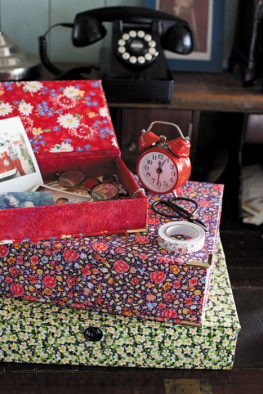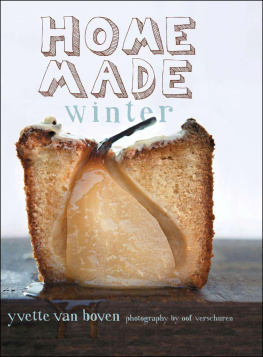
Copyright 2012 by Elwin Street Limited
Conceived and produced by
Elwin Street Limited
144 Liverpool Road
London N1 1LA
First published in the US by Lyons Press, 2012
ALL RIGHTS RESERVED. No part of this book may be reproduced or transmitted in any form by any means, electronic or mechanical, including photocopying and recording, or by any information storage and retrieval system, except as may be expressly permitted in writing from the publisher. Requests for permission should be addressed to Globe Pequot Press, Attn: Rights and Permissions Department, P.O. Box 480, Guilford, CT 06437.
Lyons Press is an imprint of Globe Pequot Press
Design and illustrations by Sarah Fotheringham
Additional text by Kelly Thompson
Library of Congress Cataloging-in-Publication Data is available on file.
ISBN 978-0-7627-8987-0
- HOME SWEET HOME
________________________________
Sarah Tomczak is the author of four books, including the successful How to Live Like a Lady. She has been a journalist for over twelve years; her career includes stints in New York and London and she has written for everyone from Us Weekly to Cosmopolitan, Glamour to Conde Nast Brides. She currently lives in London.
In our modern age of rampant consumerism, many of us are losing touch with the traditional domestic activities that previous generations took for granted. We buy everything we needand much that we dontrather than making new or making do.
Especially in the kitchen, fewer people are taking the time to make or grow things themselves. But however convenient they might be, commercially-made products can never compare to the flavors and scents that you can create at home, or to the sense of accomplishment of rolling up your sleeves and making something from scratch. Mass-produced objects can never compete with the charm of items made with the love and care of your own hands, that are an expression of your individuality.
A generation or two ago, women knew how to keep an orderly and cost-effective home. Somehow they found time to raise children, keep an immaculate house, grow vegetables, make jam, do a spot of dressmaking, polish the silver, and bake bread, all without the aid of a fridge-freezer or microwave. Over the last fifty years new gadgets, technology, and ingredients have become increasingly available to us and dramatically changed our home lives. Yet the increasing number of domestic appliances in the home has not actually given us any more spare timein fact, we seem to have less today than ever beforeand in many ways have removed a sense of personal touch from our homes.
In these pages you will find 100 simple, traditional projects and pieces of advice that will help you to rediscover the enjoyment to be had in your own home, whether baking, crafting, cooking, cleaning, or decorating. Taking a renewed interest, and indeed a measure of pride, in your home and making it beautiful does not mean a blind return to old-fashioned valuesyou should see it as a rediscovery of the domestic skills that can introduce pleasure, creativity, and a strong sense of satisfaction into our lives. It is a chance to pick up some of the best forgotten talents of generations pastwith a few modern twists to match our twenty-first-century lifestyles.
Dip in and discover how to: bake scones; make strawberry jam; keep your knives sharp; dry and preserve fruits and herbs; remove a variety of different tough stains; restore wood furniture; mix a classic martini; press flowers; make your own bubble bath; and plenty of other ways to experience the pleasure of creating from scratch and make the most of your time spent at home.
I hope that you will find this an invaluable sourcebook of traditional projects that will bring a unique charm into your life and your home.

___________________________________
12 CUPS (1.5 KG) STRAWBERRIES JUICE OF ONE LEMON
5 CUPS (1.25 KG) SUGAR
___________________________________
Makes approximately 6 jars
Prepare the strawberries by removing all tops and greenery, and chopping the large fruits into smaller chunks.
Put the strawberries and the lemon juice into a saucepan and simmer very gently for an hour.
Add the sugar and turn up the heat until the mixture setsat around 220F (105C), if you have a cooking thermometer. Skim any scum off the top, then set aside until a skin starts to form.
Pour into sterilized jars, seal them and let cool. Then label them and store in a cool place.

___________________________________
31/3 CUPS (500 G) GRANARY, WHOLEWHEAT, OR WHITE BREAD FLOUR
OZ (7 G) SACHET FAST-ACTION DRIED YEAST
1 TEASPOON SALT
1 CUP (300 ML) HAND-HOT WATER
2 TABLESPOONS OLIVE OIL
1 TABLESPOON CLEAR HONEY
___________________________________
Mix the flour, yeast, and salt together in a large bowl with your hands.
Mix the hot water with the oil and honey, then stir into the dry ingredients.
Place the dough on a lightly floured surface and knead until it no longer feels sticky, sprinkling with a little more flour if needed.
Shape the dough as desired and place in a loaf tin, leaving room for expansion. Put the tin in a large plastic food bag and leave to rise for another hour, or until the dough no longer springs back when pressed.
Pre-heat the oven to 400F (200C). Make several slashes across the top of the loaf with a sharp knife, then bake for approximately 30 minutes, or until the loaf is risen and golden.
Remove from tin and place on a cooling rack, tapping the base to check if it is cooked: It should sound hollow. Leave to cool before slicing and serving.

If youre starting from seeds, fill a 3-inch (7.5-cm) pot with potting soil and lightly water. Scatter with a generous sprinkling of seeds and then add a thin layer of vermiculitethis is a natural mineral that insulates your seeds and helps them to grow; it is available at all good garden stores.
Place on a sunny windowsill to germinateyou should see your first seedlings in two weeks, and the plants should be strong enough to move into their own pots at eight weeks.
To transplant, hold each plant by its stem and leaves, gently digging into the soil to lift it out. Place each plant into its own 3-inch (7.5-cm) pot and water lightly. Once you can see roots coming through the drainage holes at the bottom, transplant into a 5-inch (12-cm) pot.
When the first branch of flowers appears, the tomato plants are ready to go into a larger pot, or growing bags. Break up the soil well before adding the plants, and scoop out enough soil to make room for the roots, ensuring that the ball of roots is fully covered by a layer of soil. Place a growing cane next to each plant, and as your plants grow, tie them to the cane at every 4 inches (10 cm).
To ensure you get the best tomatoes, once your plant has produced four flowering branches, snap out the growing stem from the topand any shoots that grow in the leaf joints. You want one long, tall plant, as opposed to a bush, and this way the plants energy will go into producing fruit.















